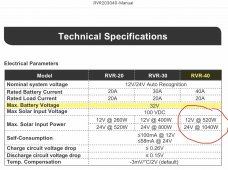Your basic idea of matching 4S1P Solargy with 2S2P Kyocera is sound. But you've been misled by some confusing nomenclature. To wit:
I’m getting ready to install solar panels on one of my systems. The setup will include six Chins 100 amp Lithium batteries, a Renogy 2000 watt pure sine wave 12 volt inverter charger and a Renogy 40 A Li charge controller. The Renogy 40 A Li charge controller is rated at 1040 watts @24 volts and max of 100 volts input.
A "40A controller" can push at most 40A
into the batteries. No matter what panels you use, max power is 40A * battery voltage.
4 Solargy Alpha Series 185 watt 24 volt panels. (740 watts at 24 volts) (62”x32”)
(Voc 44.7, 36.2 Vmp)
(5.14 amps)x4=20.56 amps
"24 Volt panel" is a nickname for a panel that kinda works OK if you simply wire the output leads directly to a discharged 24V battery. And that's basically what a PWM controller does*. With direct-connect, panel and battery voltages are the same (nominally 24V but more like 29V when charging).
But your MPPT does not directly connect panels and batteries. It converts voltages and can hold panel and battery at different voltage levels. So forget these notions of 12V and 24V panels, those terms only apply when direct-connect pulls panel voltage down to match the battery.
*PWM also has logic to disconnect the panels when needed to protect the battery (e.g. to prevent overcharging).
Hmmm… the manual says the controller auto senses battery voltage and sets charge voltage to match. Now to go back and read the manual again.
12V / 24V auto-sense is typically a lead-acid feature. Don't count on it working with your lithium batteries.
4 Kyocera 125 watt 12 volt panels. (250 watts at 24 volts) (56”x26”)
4 x 125 W = 500W. You always add Watts up, whether series or parallel. See below.
(Voc 21.7, 17.4 Vmp)
Or Voc of 43.4 using 2 sets of 2 in series and paralleling the 2 sets
(7.2 amps)x2=14.4 amps
Correct on Voc and Imp. But also note Vmp is 2 * 17.2 =
34.4V.
Totals:
36.2 Vmp x 20.56 amps = 744 watts
And
17.4 Vmp x 14.4 amps = 250 watts
Use the 34.4V here, not 17.4V. That's why it's 501W instead of 250W.
(35 amps total) Or 994 watts.
35A and 1245W.
You won't actually get 1245W. First, your 2S Kyocera strings will pull your 4S Solary string down to 34.4V. So you end up with:
Solargy: 34.4 V(not quite mp) * 20.56A = 707 W
Kyocera: 34.4 Vmp * 14.4A = 501 W
Total: 34.4V * 34.96A = 1208 W
That's nominal output at full 1000W/sqm sun, perfect tilt, 25 deg C, blah, blah. Your mileage may vary.
Secondly, as noted above, your MPPT can only send 40A to the battery. So for your 12V battery which charges at ~13V:
40A * 13V = 520W
If you only needed to power loads at night you could disconnect the inverter during the day and wire your six batteries up as 2S3P. Switch your MPPT to 24V mode and charge at the full 1040W. Once fully charged, put your MPPT back into 12V mode, rearrange the batteries into 1S6P and reconnect the inverter up. Maybe even wire up a bunch of relays up to do this automatically.
But if you need the inverter on 24x7, you're stuck with 520W charging. You could switch to a 24V inverter or a 80A MPPT. But I agree adding your spare 40A MPPT is the obvious choice.




